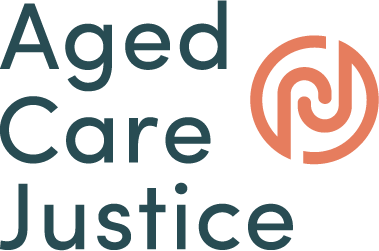Nutrition in Aged Care
By Jack Watson & Jennifer Murray[1]

A nutritious diet is a fundamental aspect of health and wellbeing. However, it is estimated that between 22% and 50% of older people living in Australian residential aged care are malnourished or at risk of malnutrition[2]. Several factors contribute to the poor nutrition of aged care residents including:
- lack of assistance for residents unable to feed themselves, whether due to physical limitation or impaired cognitive function that impedes the resident’s capacity to recognise the need for regular food and drink;
- inability of staff to cater for a resident’s individual requirements regarding eating and drinking;
- unwillingness of some aged care facilities to provide a sufficient budget allocation for nutritious food and ensure that staff have sufficient time to provide assistance to residents during mealtimes;
- some residents lack the motivation to eat and drink regularly.
Why is improving aged care nutrition so important?
Poor nutrition can have severe effects on both physical and mental health. Maggie Beer AM states;
Good nutrition stimulates the senses, supports health and wellbeing, provides pleasure, conveys respect and care, and acts as a facilitator for social interaction. It provides a sense of purpose and anticipation. It is at the heart of quality of life.[3]
Providing better nutrition can greatly enhance the quality of life for aged care residents particularly if residents are given greater choice over their diets.
Further, increased incidences of falls, fractures and pressure injuries resulting in needless hospitalisation among aged care residents can be linked to inadequate nutrition.[4] It is likely that improved nutrition could reduce these high rates of injury and hospitalisation and have many further physical benefits for residents.
Some Shocking Facts
- The average expenditure allocated to resident’s daily food intake in Australia is $6.08. This shockingly low number is steadily decreasing despite rising food prices.[5]
- Several aged care workers have admitted that because of insufficient funding (see above) portion sizes are sometimes made smaller and leftover food products are re-used.[6]
- An ABC Four Corners report (2018) raised allegations of staff removing food from residents if they did not eat quickly enough.[7]
These facts indicate that increased funding for the aged care sector, plus aged care facilities allocating more finances for residents’ food and drink, are critical to the improvement of the diet and nutrition of residents.
What changes can be made?
Naturally for any improvement to be made, it is imperative that aged care facilities be prepared to increase the amount of money they spend on food and meal preparation. The current average of $6.08 is simply insufficient to meet the nutritional needs of residence.
Additionally, a more targeted approach must be implemented to improve nutrition in residential aged care facilities. This can be achieved by providing enhanced dietary options for residents. A recent University of Queensland study illustrated that of all areas in residents’ everyday life they deemed important to control, nutrition was the most salient.[8] This is why ALARM proposes that, where feasible, aged care residents should be given the option to prepare their own meals. It is general practice at some aged care facilities for food to prepared off-site and brought in by a contractor, with food distributed to residents in plastic containers.[9] This demonstrates a worrying lack of residents’ control over their own nutrition and contributes to the negative impact on their physical and mental health. Consequently, giving residents the option to cook for themselves, where possible, and allowing them to contribute to food preparation and have input into their diet, should drastically improve their quality of life. Such activity would also help maintain residents’ cognitive and physical abilities and provide them with crucial social interaction that would likely increase their motivation to regularly eat and drink.
Further, employing allied health care professionals (e. g., specialised dieticians and speech pathologists) at aged care facilities, would enable more targeted solutions to unique dietary and nutrition concerns individual residents may have. For instance, a speech pathologist can assist residents with issues of swallowing, eating, and drinking and provide them with the necessary assistance that is currently lacking. A dietician can construct healthy, unique dietary plans to combat the exorbitant rates of malnutrition and target the specific dietary needs of each resident.
With these proposals we believe that major improvements can be made to the nutritional health of aged care residents. Adjusting residents’ diets, even only slightly, would be a key factor in improving the physical and mental health of aged care residents.
Get Help
If you or someone you know needs legal assistance, we encourage you to fill out ALARM’s GetHelp form on our website at www.ALARM.ORG.AU; or contact ALARM on (03) 9016 3248; or email us on info@agedcarejustice.org.au. You may then select, or, if you wish, we will direct you to, one of our Allied Law Firms for an initial meeting and advice, at no cost to you. Thereafter, you can decide whether to proceed with a formal legal complaint. If you do wish to proceed, costs arrangements, if any, will need to be discussed, and agreed, with the firm.
Sources:
[1] Jack Watson, law student, Monash University; Jennifer Murray, law graduate, Newcastle University, ALARM Inc volunteers. The authors acknowledge the assistance of senior ALARM volunteer lawyers in the preparation of this article.
[2] Morgan Liotta, ‘Aged care facility food allowances ‘cutting corners’ NewsGP (Blog Post 17 July 2019)
https://www1.racgp.org.au/newsgp/professional/aged-care-facility-food-allowances-cutting-corners; Dietitians Association of Australia, ‘Submission- Royal Commission into Aged Care Quality and Safety’ March 2019 https://dietitiansaustralia.org.au/wp-content/uploads/2019/03/DAA_Royal-Commission-Aged-Care_Mar-2019_Final.pdf
[3] Liz Alderslade, ‘Maggie Beer Foundation delivers urgent aged care food and nutrition report to Government’, Aged Care Guide (Blog Post, March 2021) https://www.agedcareguide.com.au/talking-aged-care/maggie-beer-foundation-delivers-urgent-aged-care-food-and-nutrition-report-to-govt
[4] Sally Watson, Zhongxian Zhang and Tim Wilkinson ‘Nutrition risk screening in community‐living older people attending medical or falls prevention services’ (2010) Nutrition & Dietetics 67(2) 84.
[5] Cherie Hugo et al. ‘What does it cost to feed aged care residents in Australia?’ (2018) Nutrition & Dietetics 75(1) 6.
[6] Cherie Hugo et al. ‘What does it cost to feed aged care residents in Australia?’ (2018) Nutrition & Dietetics 75(1) 6.
[7] ABC, ‘Who Cares?’, Four Corners, 18 September 2018 (Sarah Ferguson).
[8] Karen Abbey, Olivia Wright and Sandra Capra ‘Menu planning in residential aged care—the level of choice and quality of planning of meals available to residents’ (2015) Nutrients 7(9) 7580.
[9] Royal Commission into Aged Care Quality and Safety (Final Report, March 2021) vol 3A, 101.
Disclaimer:
The views expressed in this article are the views of the author. The contents of this article are for general information purposes only and do not constitute legal advice, are not intended to be a substitute for legal advice, and should not be relied upon as such. Legal advice should be sought prior to any action being taken in reliance on any of the information. If you are in need of legal advice and/or assistance about aged care matters, please seek legal advice directly or via ALARM’s GET HELP form on this website.
